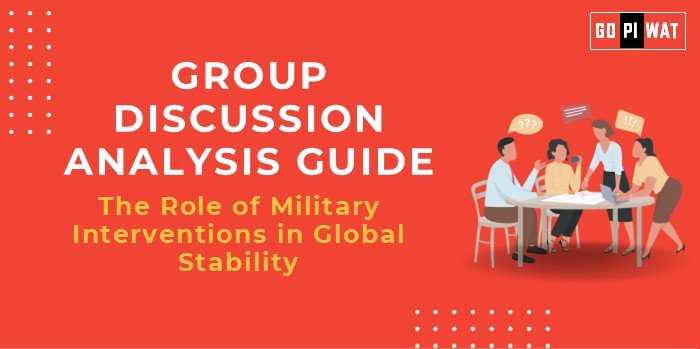📋 Group Discussion Analysis Guide
🌐 The Impact of Foreign Military Interventions on Global Peace
📖 Introduction to the Topic
Context: Foreign military interventions have often been justified as necessary actions to restore peace, address conflicts, or prevent humanitarian crises. However, their long-term impact on global stability remains highly debated.
Background: Military interventions have ranged from large-scale wars to targeted operations, often involving coalitions under the UN, NATO, or unilateral actions by states. Recent examples, such as interventions in Afghanistan, Libya, and Syria, highlight the complexities and unintended consequences.
📊 Quick Facts and Key Statistics
- 💼 Global Defense Spending (2023): $2.24 trillion – Demonstrates the scale of resources dedicated to military operations.
- 🌍 UN Peacekeeping Missions: Over 12 ongoing operations – Reflects international efforts toward conflict resolution.
- 👥 Civilian Displacement: Nearly 110 million displaced due to conflicts (UNHCR, 2023) – Highlights the humanitarian toll of interventions.
- 📉 Success Rate of Peacebuilding (Post-Intervention): 40% (World Bank) – Indicates mixed outcomes of military actions.
🌟 Stakeholders and Their Roles
- 🏛️ United Nations: Advocates for multilateralism and peacekeeping.
- 🌐 Governments of Intervening States: Pursue strategic, political, or humanitarian goals.
- 🌍 Host Nations: Bear the brunt of intervention consequences.
- ⚔️ Non-State Actors: Rebel groups or terror organizations often emerge as players in conflict zones.
- 🤝 Civil Society & NGOs: Work on rehabilitation, peacebuilding, and advocacy.
🏆 Achievements and Challenges
✨ Achievements
- ✅ Restoration of Order: NATO’s intervention in the Balkans (1990s) curtailed ethnic cleansing.
- 💊 Humanitarian Aid: Timely interventions in regions like Sudan saved lives.
- ⚔️ Terrorist Containment: Operations in Afghanistan dismantled major terror networks.
⚠️ Challenges
- ⚖️ Civilian Casualties: Drone strikes and bombings often harm civilians, as seen in Yemen.
- 📉 Prolonged Instability: Iraq and Libya faced governance vacuums post-intervention.
- 🌐 Global Criticism: Unilateral interventions (e.g., Iraq 2003) strain international relations.
📘 Global Comparisons:
– Successful Example: Sierra Leone (UN intervention helped stabilize post-civil war).
– Challenging Example: Syria, where external interventions exacerbated divisions.
– Case Studies:
– Afghanistan: Mixed outcomes; initial gains against terrorism followed by the Taliban’s resurgence.
– Libya: NATO’s intervention toppled Gaddafi but resulted in ongoing chaos.
💬 Structured Arguments for Discussion
- ✅ Supporting Stance: “Foreign military interventions are crucial in preventing genocides and stabilizing volatile regions.”
- ❌ Opposing Stance: “Military interventions often lead to prolonged instability, as seen in Iraq and Afghanistan.”
- ⚖️ Balanced Perspective: “While interventions can address immediate crises, their success depends on robust post-conflict strategies.”
💡 Effective Discussion Approaches
- 🌏 Opening Approaches:
- Begin with a significant statistic or case (e.g., civilian casualties in Yemen).
- Pose a thought-provoking question: “Do military interventions secure peace or sow seeds of future conflicts?”
- 🤔 Counter-Argument Handling:
- Highlight alternative strategies (e.g., diplomacy, sanctions).
- Use examples of successful non-military conflict resolutions (e.g., South Africa’s post-apartheid transition).
🔍 Strategic Analysis of Strengths and Weaknesses
- 💪 Strengths: Multilateral cooperation; prevention of large-scale atrocities.
- ⚖️ Weaknesses: High civilian toll; financial costs; regional destabilization.
- 📈 Opportunities: Strengthen international law; focus on peacebuilding.
- ⚠️ Threats: Escalation into proxy wars; backlash against intervening nations.
🎓 Connecting with B-School Applications
- 🌍 Real-World Applications: Analyze foreign policy impacts on global markets; operational strategies in conflict zones.
- 💬 Sample Interview Questions:
- “What are the economic implications of foreign military interventions?”
- “Can peacekeeping efforts be restructured for better efficiency?”
- 💡 Insights for Students:
- Explore models of conflict resolution.
- Analyze the intersection of diplomacy and business.


